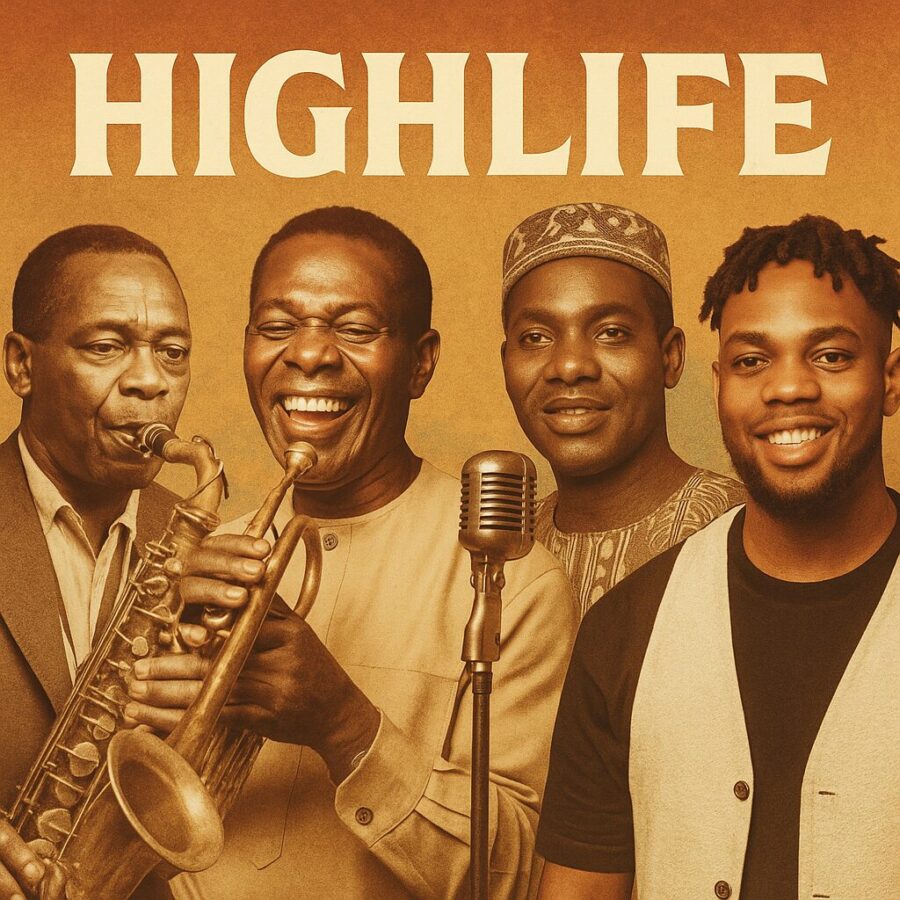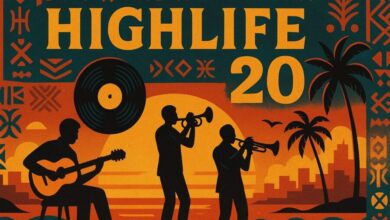
Highlife is more than just a music genre – it is the heartbeat of 20th-century West African culture, a sound that carried the aspirations of nations, the romance of young lovers, and the spirit of communities in transition from colonial rule to independence. Born in Ghana, adopted and transformed in Nigeria, and carried throughout Africa and the diaspora, Highlife remains a pillar of African music. Its rich blend of brass, guitars, and syncopated rhythms became the foundation for later genres such as Afrobeat, Afropop, and even modern Afrobeats dominating global charts in 2025.
Origins: Colonial Ghana and the Birth of Highlife
Highlife traces its beginnings to coastal Ghana in the late 19th and early 20th centuries. During British colonial rule, European military bands played waltzes, polkas, and ballroom music for colonial officers. Local Ghanaian musicians began to absorb and reinterpret these foreign sounds, blending them with traditional rhythms and melodies. Out of this cross-cultural exchange emerged two key streams of early Highlife: brass-band highlife and palm-wine highlife.
Brass-band highlife was performed in elite clubs, colonial ballrooms, and later public gatherings. It featured trumpets, trombones, saxophones, and percussion – echoing European marching bands but reimagined with African rhythm and call-and-response. This version of highlife quickly became associated with the “high life” enjoyed by Ghana’s elite, which is where the genre took its name.
Palm-wine highlife, on the other hand, was grassroots. It developed in coastal towns and fishing communities, where itinerant sailors and laborers played acoustic guitars while drinking local palm wine. These small ensembles sang about everyday life – love, hardship, work – and used West African folk progressions. Palm-wine highlife carried the raw emotional core of the genre and eventually merged with the brass tradition to form modern Highlife.
The Golden Age: E.T. Mensah and Ghana’s Highlife Explosion
No figure is more central to Highlife’s golden age than E.T. Mensah, often called the “King of Highlife.” In the 1950s and 1960s, his band, the Tempos, electrified Ghana with smooth horn arrangements, jazzy saxophone solos, and infectious dance rhythms. Mensah’s songs like “All for You” and “Ghana Freedom” became anthems of the independence movement.
At this time, Ghana had just gained independence (1957), and highlife became the soundtrack of national pride. It was played at weddings, state events, and nightclubs, symbolizing modern African identity. Mensah also toured widely, spreading highlife across Nigeria, Sierra Leone, and the UK. By the 1960s, highlife was no longer just Ghana’s music – it was West Africa’s first truly international genre.
Nigerian Highlife: The Igbo and Yoruba Flourish
By the mid-20th century, Highlife had traveled to Nigeria, where it found fertile ground in Lagos and Eastern Nigeria. Nigerian musicians infused the genre with local languages and rhythms, giving birth to unique strands of highlife that resonated with the country’s diverse ethnic groups.
- Victor Olaiya: Known as the “Evil Genius of Highlife,” Olaiya blended Yoruba rhythms with swing and jazz. His songs, such as “Baby Jowo”, remain classics, and his influence stretched into Afrobeat – Fela Kuti once played in his band.
- Rex Lawson: From the Niger Delta, Lawson’s soulful style and trumpet-driven songs made him a legend. His “Sawale” remains a cultural touchstone and has been remixed countless times across Africa.
- Chief Stephen Osita Osadebe: The Igbo maestro, Osadebe was known for his philosophical lyrics, long-form compositions, and smooth vocals. His song “Osondi Owendi” (meaning “One Man’s Meat is Another Man’s Poison”) remains one of the most enduring Nigerian highlife tracks.
Highlife Across Africa
By the 1960s and 1970s, Highlife was no longer confined to Ghana and Nigeria. In Sierra Leone, Liberia, and Côte d’Ivoire, local bands adopted the sound. In Congo, highlife intersected with soukous and rumba. In London, where many West African students and musicians migrated, highlife bands like Fela Ransome-Kuti’s Koola Lobitos and Osibisa introduced African sounds to European audiences, paving the way for global Afro-fusion.
In the Caribbean, highlife rhythms echoed in calypso and reggae, while African diasporas in the U.S. linked it with jazz and funk. Highlife had become a global sound, part of the African musical diaspora that reshaped popular music worldwide.
Decline: The Rise of Afrobeat and Juju
By the late 1970s, Highlife began to decline in mainstream popularity. The reasons were both musical and political. In Ghana, economic hardship and political instability weakened the nightclub scene that had fueled highlife’s growth. In Nigeria, new genres rose to prominence: Juju music, led by King Sunny Ade, offered Yoruba guitar brilliance, while Afrobeat, pioneered by Fela Kuti, fused highlife with jazz, funk, and radical politics. Afrobeat’s global acclaim shifted attention away from traditional highlife, and by the 1980s, it seemed relegated to nostalgia and social ceremonies.
Revival and Modern Highlife
Yet, Highlife never truly died. In Nigeria, it remained the lifeblood of Igbo cultural ceremonies – weddings, funerals, and festivals. In Ghana, young artists experimented with merging highlife with hiplife (a fusion of hip hop and highlife). The 2000s saw a revival led by artists like Flavour N’abania, whose hit “Ada Ada” reintroduced highlife to younger generations. Flavour’s modernized sound – blending traditional guitars with Afropop production – made him a continental superstar.
Similarly, contemporary stars like Burna Boy have incorporated highlife melodies into Afrofusion, while Wizkid and Davido often sample or reference highlife guitar progressions in their Afrobeats hits. This demonstrates highlife’s continuing DNA in modern African pop.
Highlife in the Diaspora
Today, highlife thrives not just in Africa but in diasporic communities across the UK, U.S., and Europe. Ghanaian and Nigerian diasporas maintain highlife nights in London and New York. Younger Afro-diaspora musicians experiment with highlife samples in hip hop and R&B. Platforms like YouTube and TikTok have sparked renewed interest in vintage highlife recordings, as younger listeners discover the elegance of Osadebe and Rex Lawson.
Highlife in 2025: The Living Legacy
In 2025, Highlife is experiencing another renaissance. Festivals in Ghana and Nigeria now include Highlife tribute nights. International artists collaborate with Highlife veterans to sample classic tracks. On Spotify and Apple Music, curated playlists of “Golden Age Highlife” are reaching new global audiences. In weddings across Lagos, Accra, and London, highlife bands still serenade crowds with timeless tunes. And in classrooms, music scholars highlight highlife as the foundation of Africa’s global sound dominance.
Why Highlife Matters
Highlife is more than nostalgic music – it is a cultural archive of West Africa. It tells stories of love, migration, colonial struggle, independence, and modern identity. Without highlife, there would be no Afrobeat, no Afropop, and perhaps no Afrobeats wave sweeping the world today. Its horns, guitars, and rhythms laid the bedrock for Africa’s musical future. In 2025, as African sounds dominate global charts, Highlife stands as the root – the golden sound that started it all.
From Ghana’s colonial ballrooms to Nigeria’s vibrant dancehalls, from E.T. Mensah’s jazz-infused horns to Flavour’s Afropop fusions, Highlife has traveled a remarkable journey. It remains a genre of elegance, community, and resilience. Even as the world moves to new sounds, the essence of Highlife – joyful horns, storytelling vocals, and syncopated rhythms – continues to inspire. It is not only West Africa’s golden sound but also one of the great legacies of global music history.

